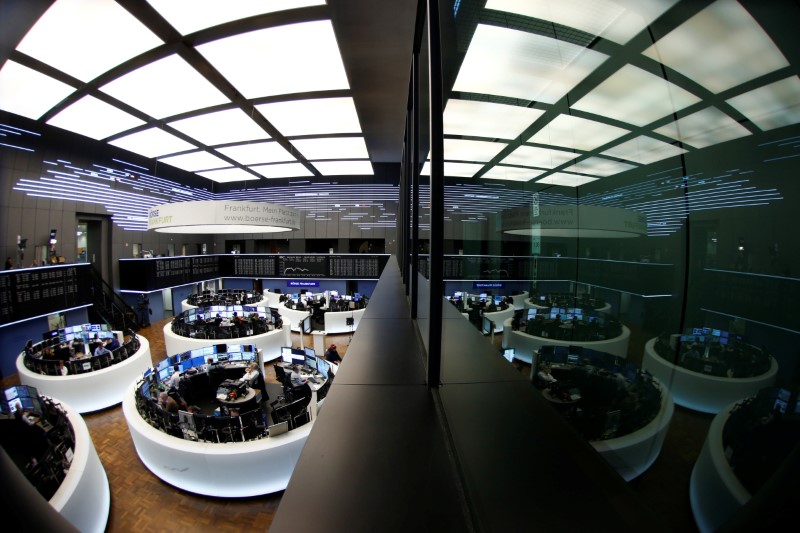By Helen Reid, Robin Pomeroy and Peter Graff, Reuters
LONDON (Reuters) – World stocks enjoyed a strong bounce on Friday with European shares recovering from a turbulent week of selling as investors’ fears of higher barriers to trade came closer to becoming reality.
MSCI’s index of world stocks rose 0.5 percent by 1045 GMT, its strongest gain in three weeks, but its second quarter was still set to be in the red as investors priced in U.S. tariffs set to be implemented next week.
The U.S. administration is due to activate tariffs on Chinese goods worth $34 billion on July 6, which is expected to prompt a tit-for-tat response from Beijing.
European stocks rallied strongly, with the pan-European STOXX 600 up 1 percent and Germany’s trade-sensitive DAX up 1.2 percent.
U.S. stock futures also rose 0.3 to 0.4 percent, though they briefly spiked lower after Axios reported that U.S. President Donald Trump has repeatedly told aides he wants to withdraw from the World Trade Organization.
It was the latest sign of investors’ heightened sensitivity to any signs of deepening divides over trade. Tariff disputes have already mauled assets from the Chinese yuan to European autos stocks, and wiped $1.75 trillion off the value of world stocks since June 12.
The euro jumped after leaders at an EU summit reached an agreement on migration, rising 0.6 percent to $1.1635. That eased a threat to German Chancellor Angela Merkel’s ruling coalition over the issue.
“The outcome of the summit tells us something about the severity of the situation,” said Jan von Gerich, chief analyst at Nordea in Helsinki.
“I’m not confident it will solve the underlying issues but there was a fear that the summit would fail and we could get a collapse of the German government, so that risk premium is being priced out,” he said.
STOCKS GAIN, YUAN PAIN
While Asian stocks rose, the Chinese yuan suffered its worst month on record, losing 3 percent against the dollar in June as investors pulled money from a market likely to suffer from higher barriers to trade.
The Chinese yuan traded as low as 6.6441 to the dollar on Friday, its lowest since November, as investors speculated China may seek to devalue its currency to compensate for higher tariffs.
“We continue to believe that the yuan movements are largely reflecting EM FX movements, and are not a sign of a concerted effort to devalue,” said BBH currency strategists.
Despite gains on Friday, the CSI300 and Shanghai Composite are the world’s worst-performing major indexes this year.
In strong contrast to the yuan, the U.S. dollar was set for its strongest quarterly gains since Q4 2016, helped by the U.S. Federal Reserve’s move to raise interest rates in June, and expectations of further hikes this year.
The dollar index edged down 0.5 percent to 94.924 on the day as the euro rose, and the greenback was up 0.1 percent against the yen at 110.65.
European bonds diverged, with the EU Summit migration agreement pushing Germany’s Bund yields up while Italian 10-year government bond yields fell to a one-week low.
The yield on benchmark 10-year Treasury notes held steady at 2.8419 percent and the yield curve widened slightly to 33.3 basis points.
Some investors see its flattening as a sign recession may be around the corner.
Intensifying trade tariff fears contrasted with a still strong picture of the global economy and robust company earnings growth.
“Our view for this year has been that asset markets would likely underperform the real economy as peaking growth momentum, tighter financial conditions, higher inflation and more volatility would act as a drag on valuations even as EPS trends remain solid,” said Morgan Stanley analysts, cutting their index targets for MSCI Europe on Thursday.
Despite trade tensions, the STOXX 600 remained on track for its strongest quarter since Q1 2017, and Britain’s FTSE 100 was set for its biggest quarterly gain since 2010.
Oil prices extended their gains to fresh highs on a tighter market as U.S. sanctions against Iran threatened to remove a substantial volume of crude oil from world markets amid rising demand.
U.S. crude inched up 0.04 percent to $73.49 a barrel. Brent crude rose 0.2 percent to $78.01 per barrel.
Gold remained near 6 1/2 month lows, weighed down by trade worries, interest rate expectations and the strong dollar.
Spot gold traded up 0.2 percent at $1250.81 per ounce, but was still headed for its worst monthly performance since November 2016.
Emerging stocks jumped 1.9 percent, having hit a one-month low in the previous session. The index was still set for its worst month since January 2016 as the rising dollar battered emerging economies.




